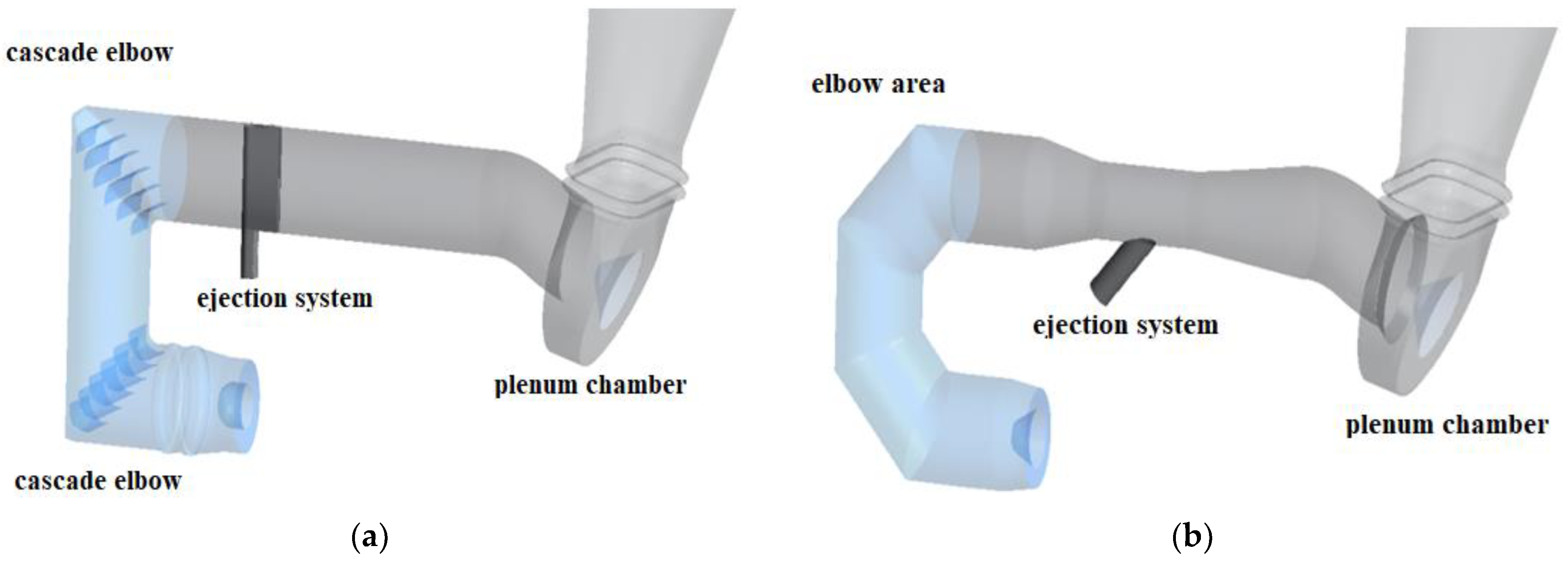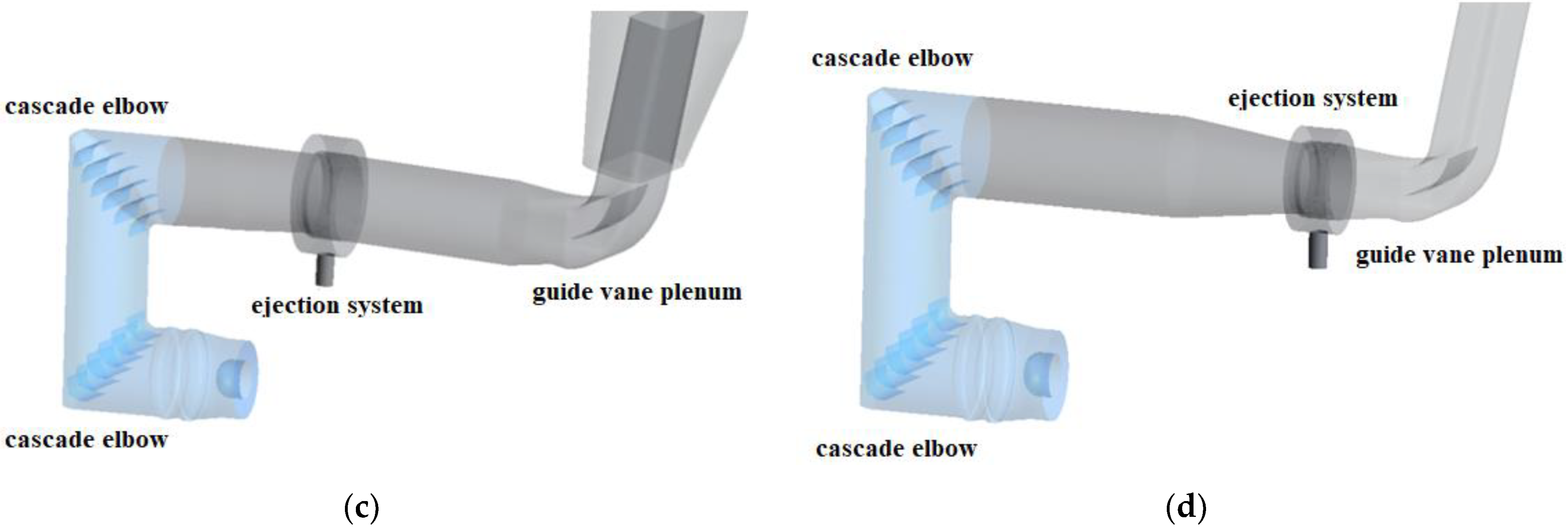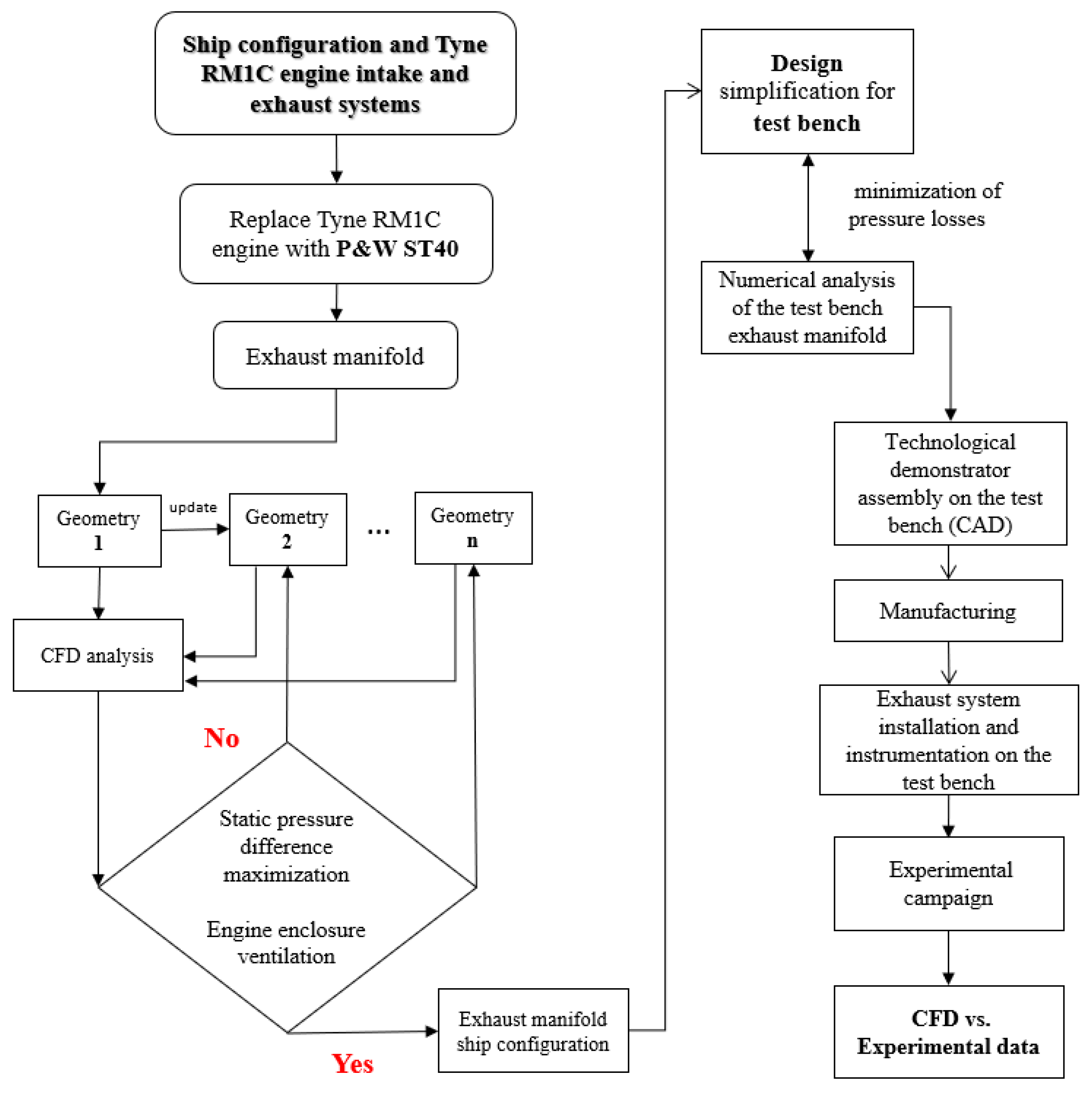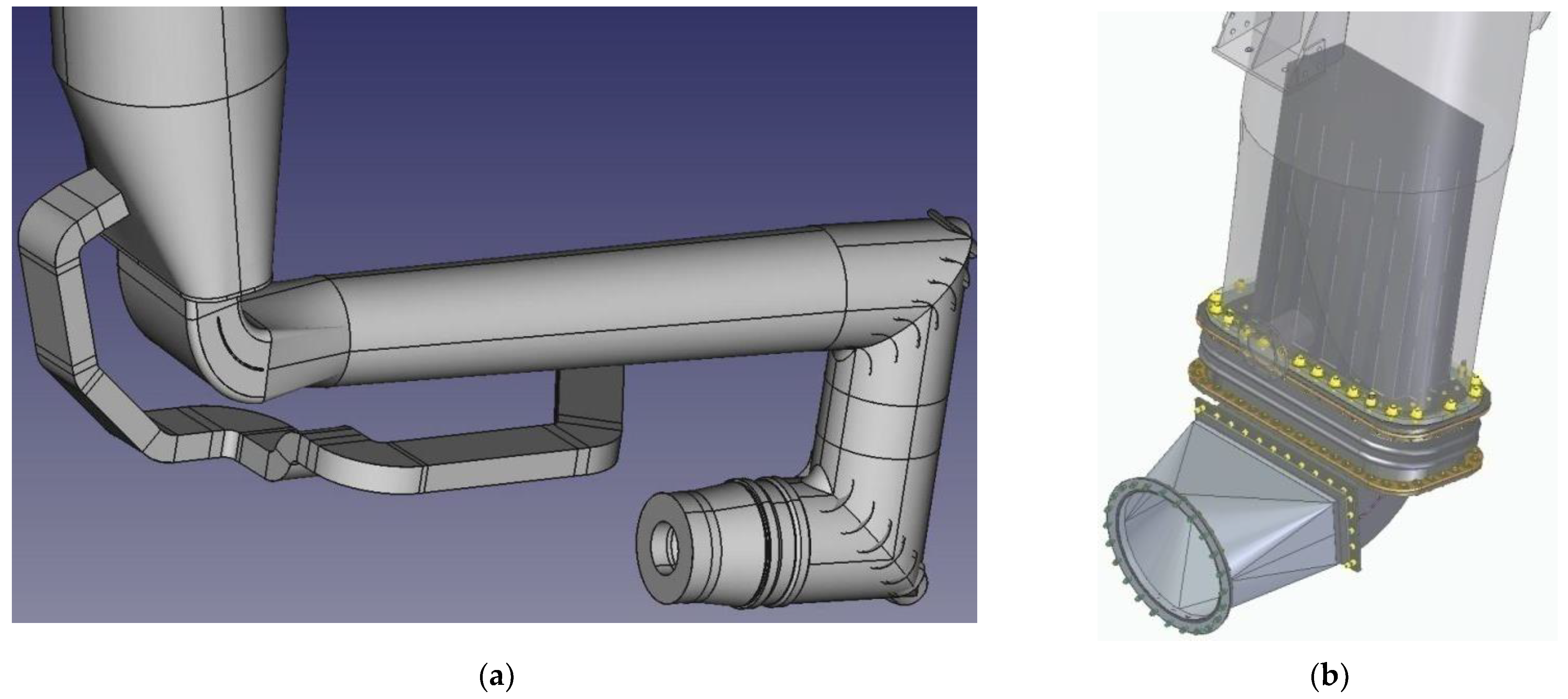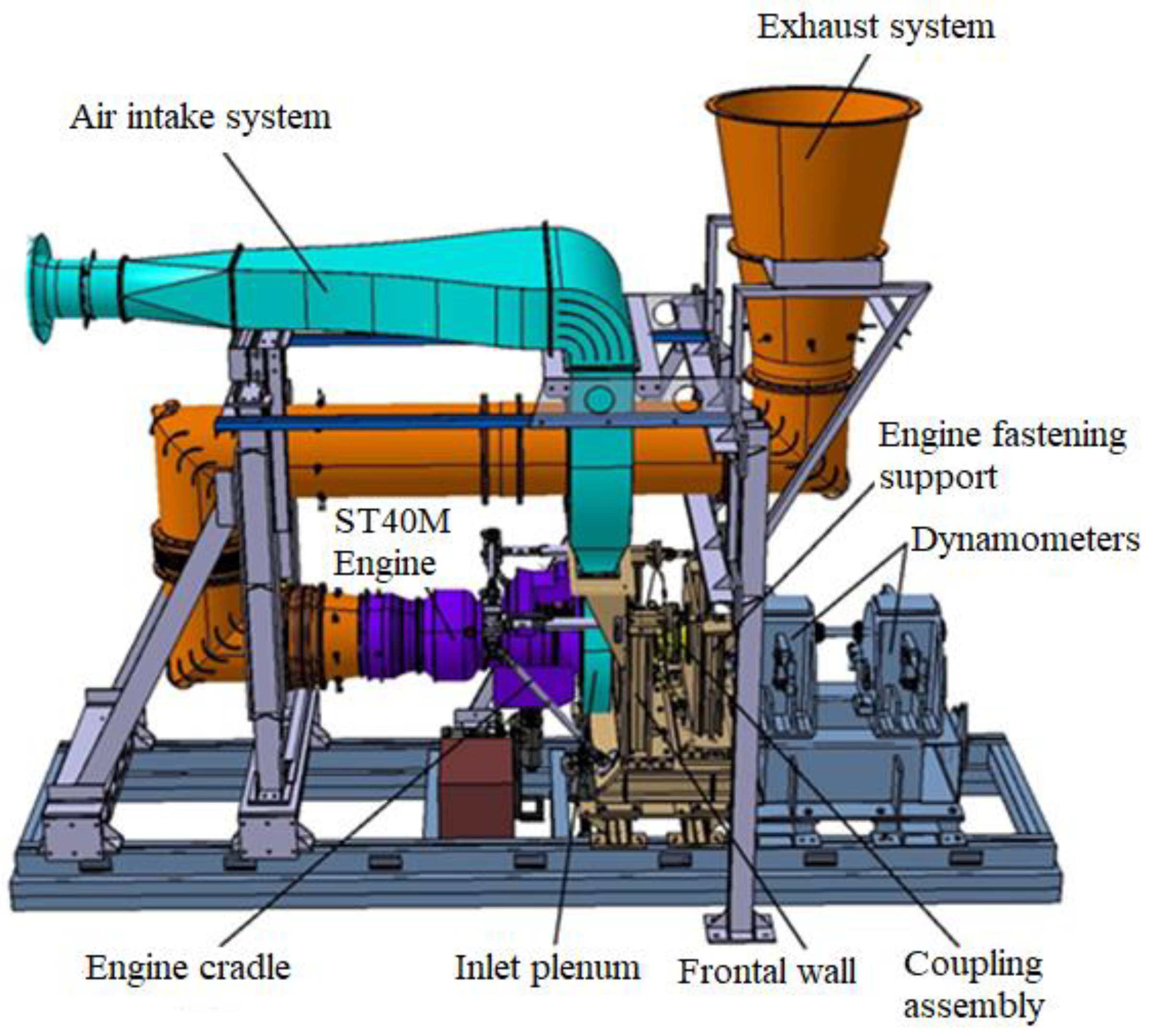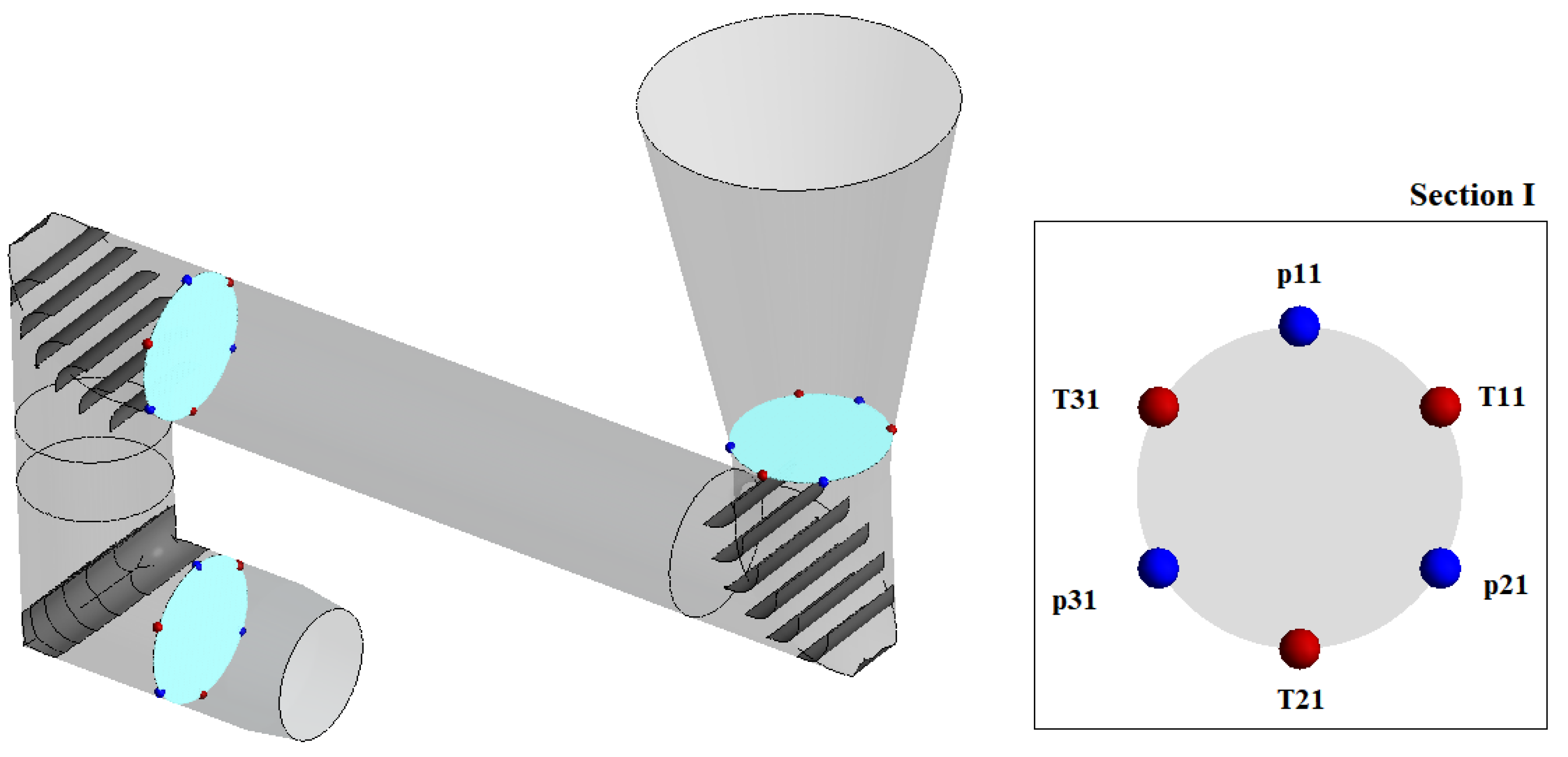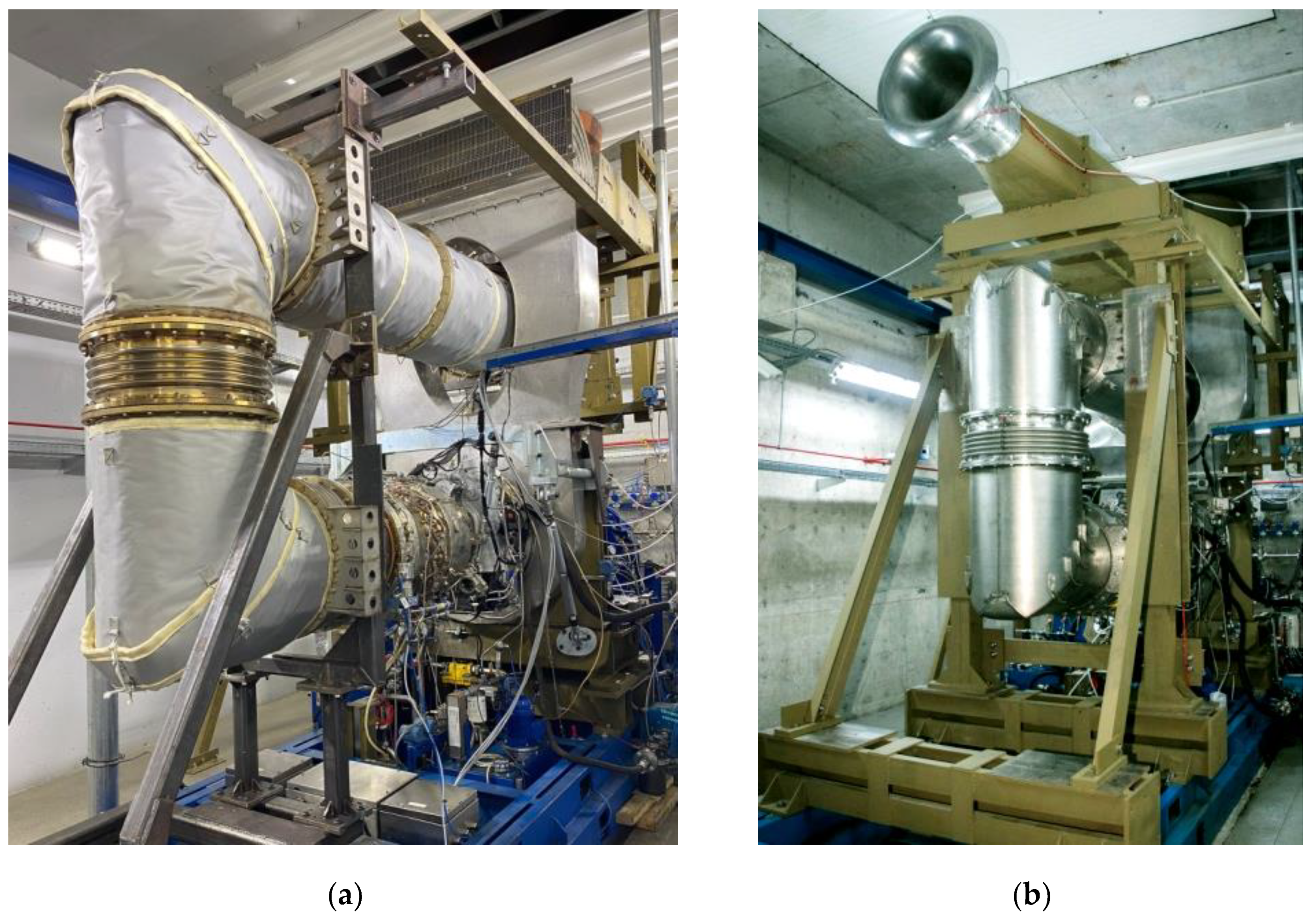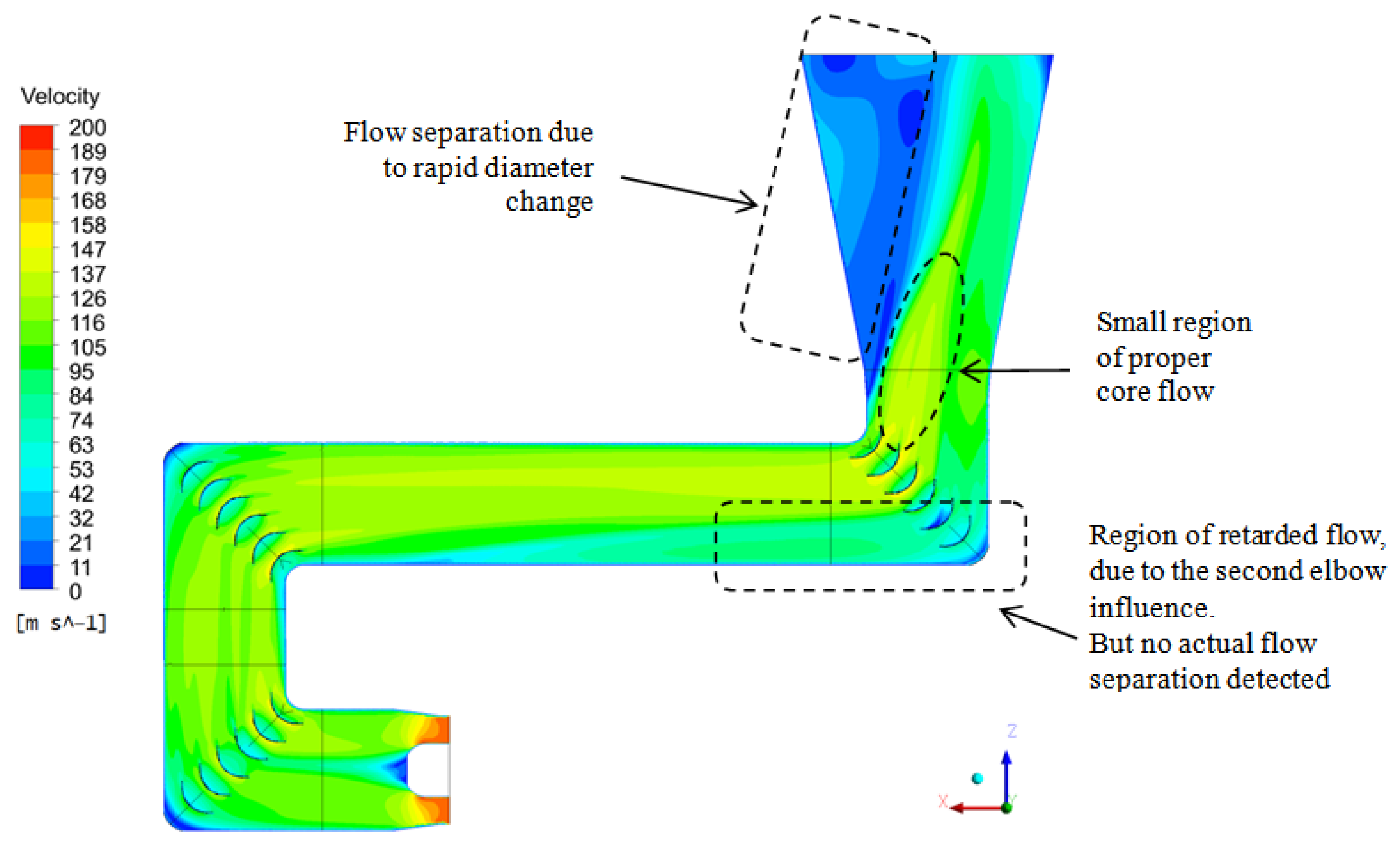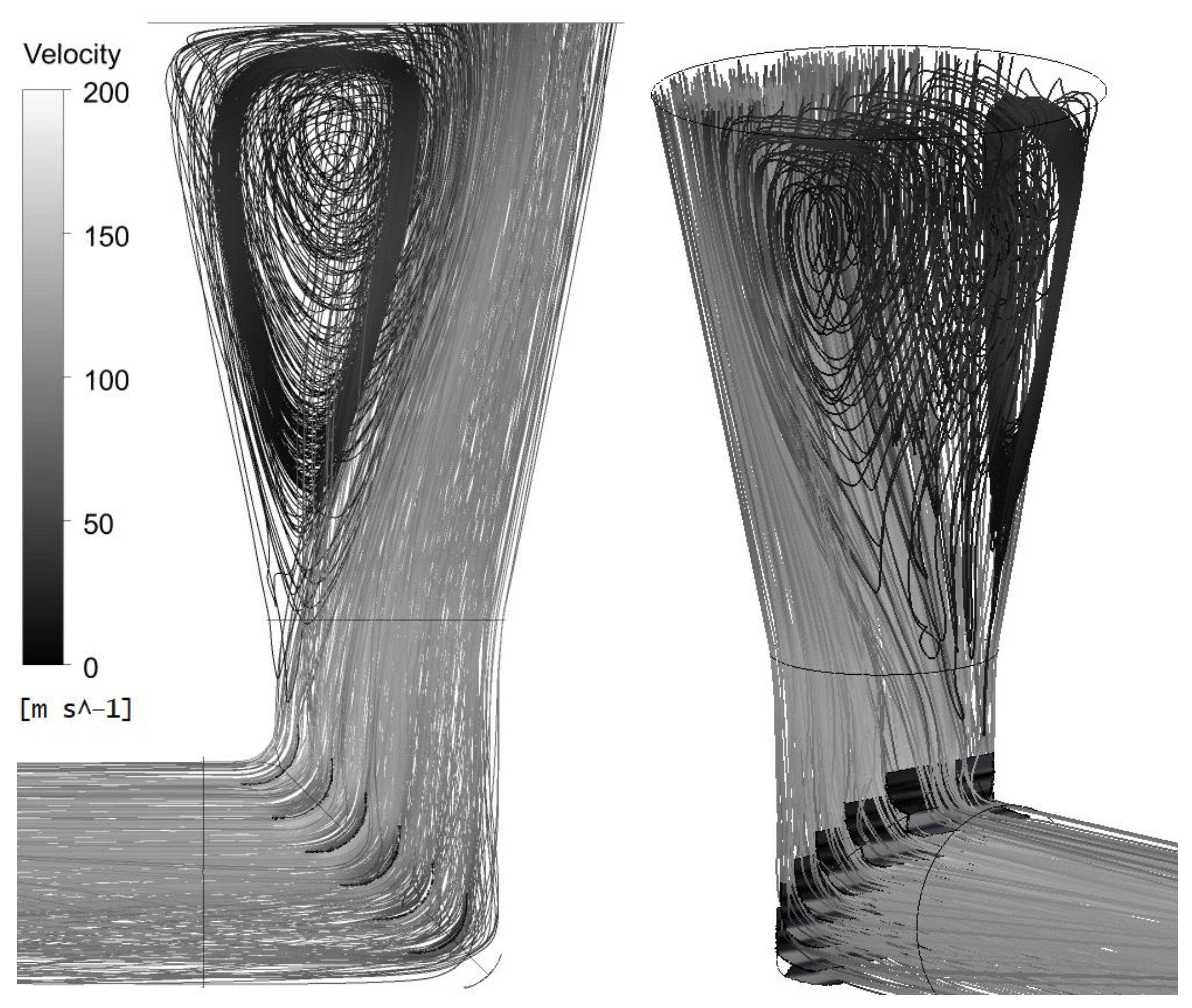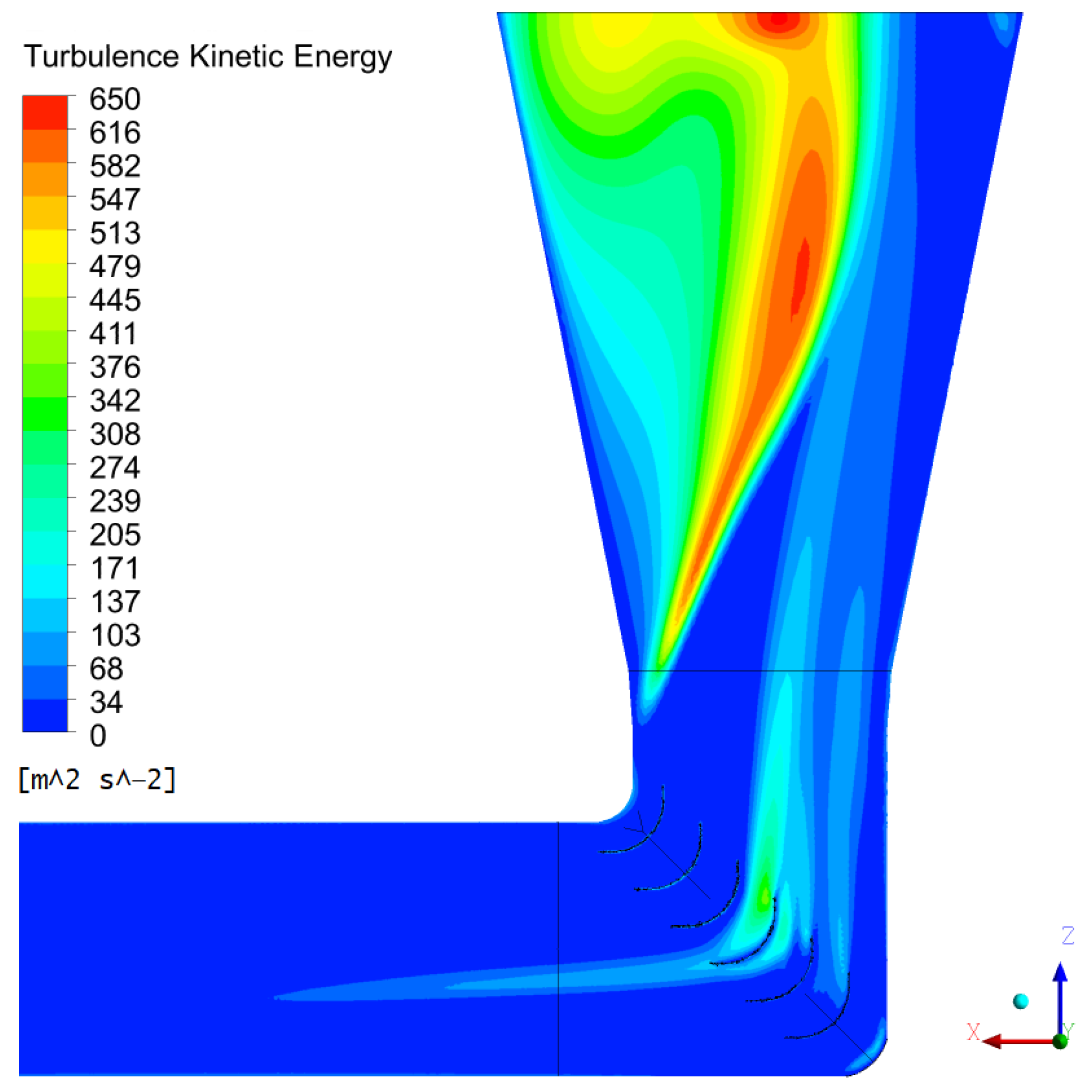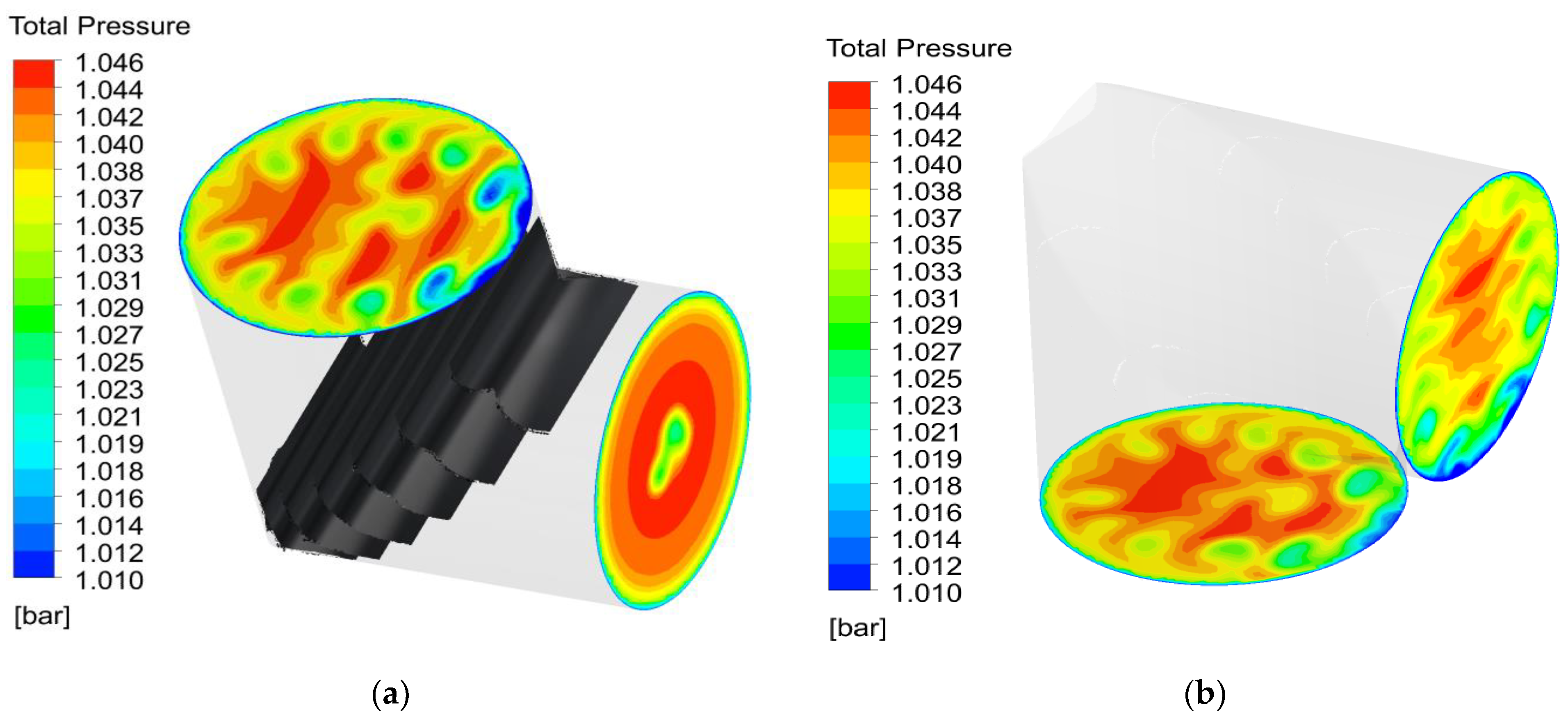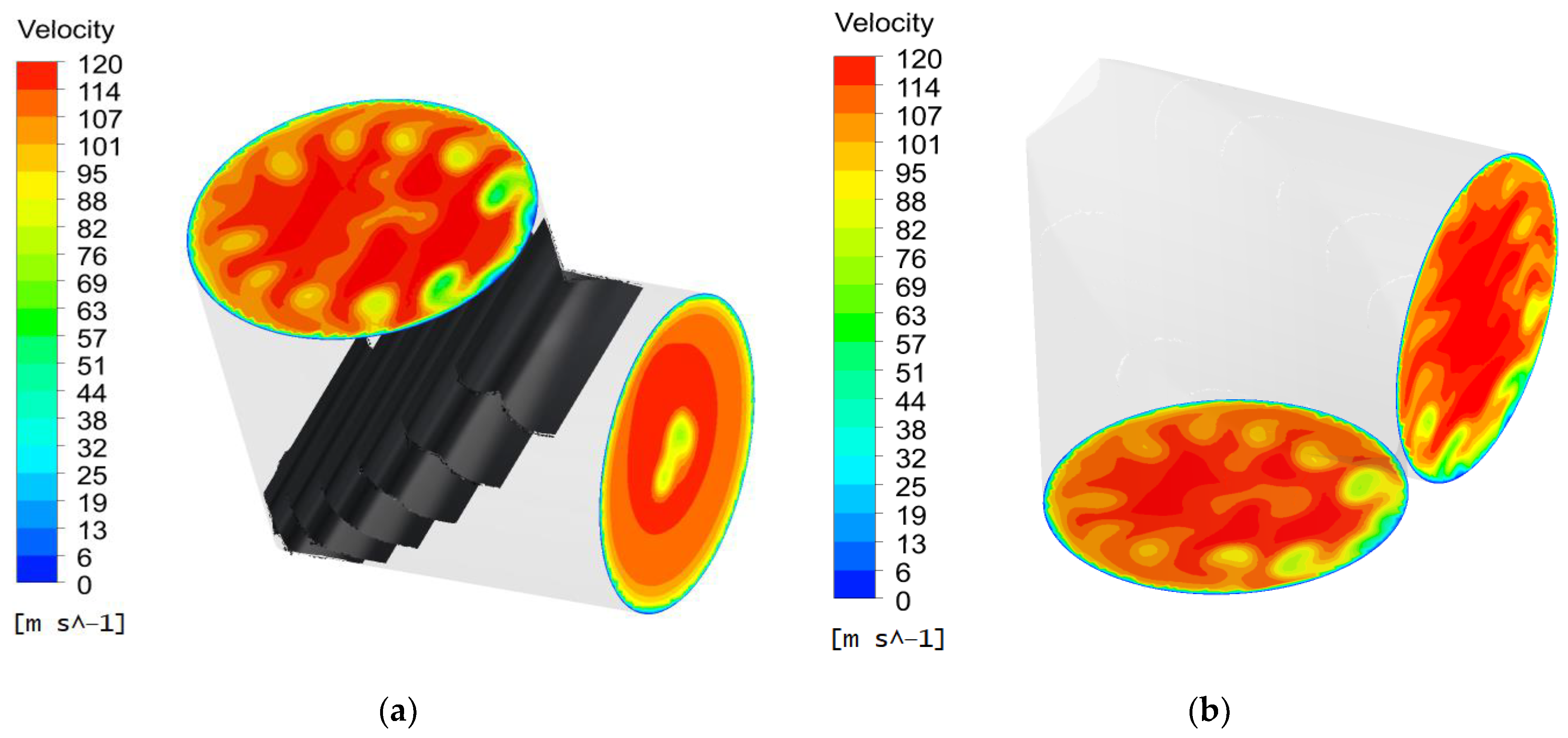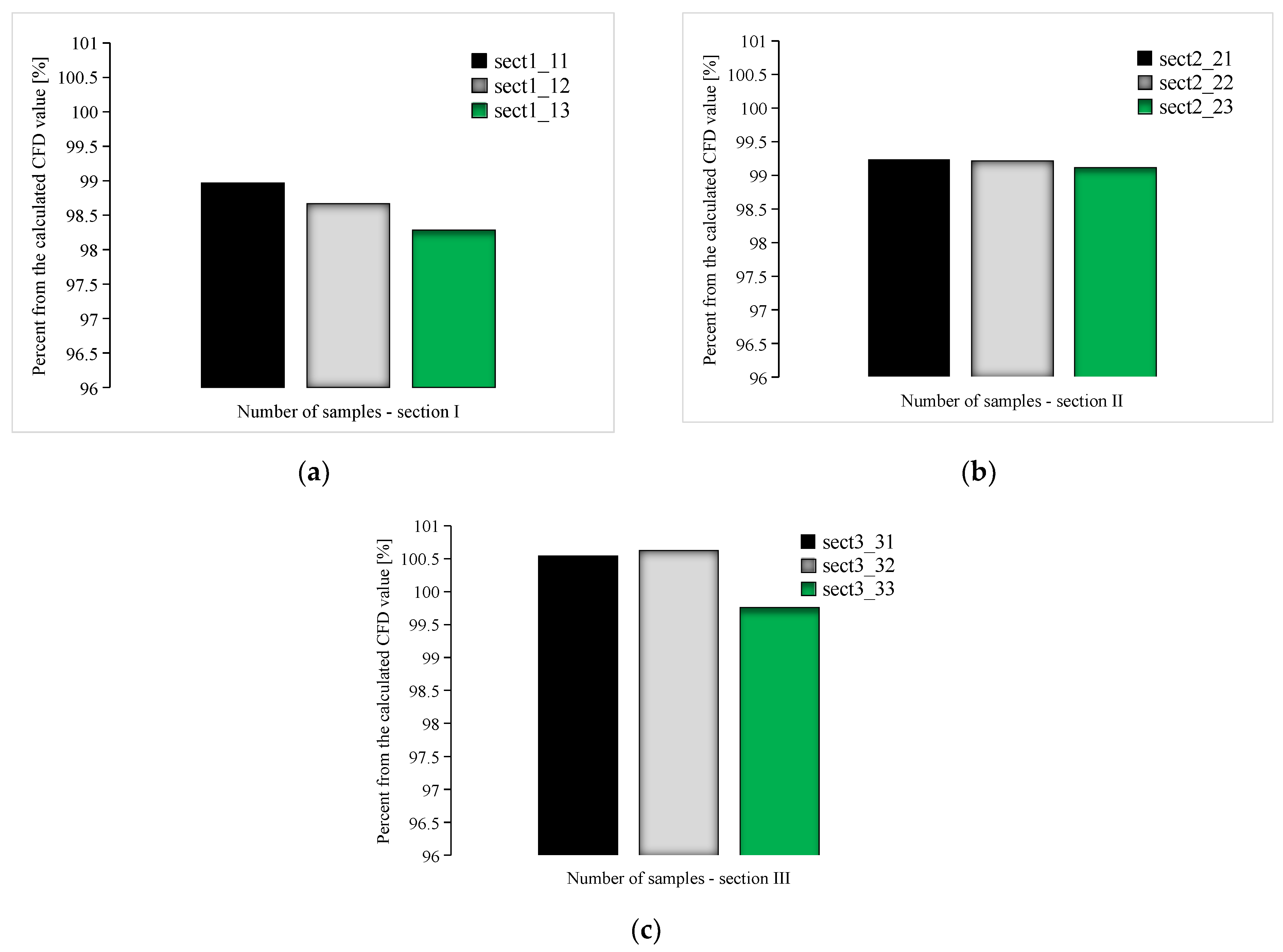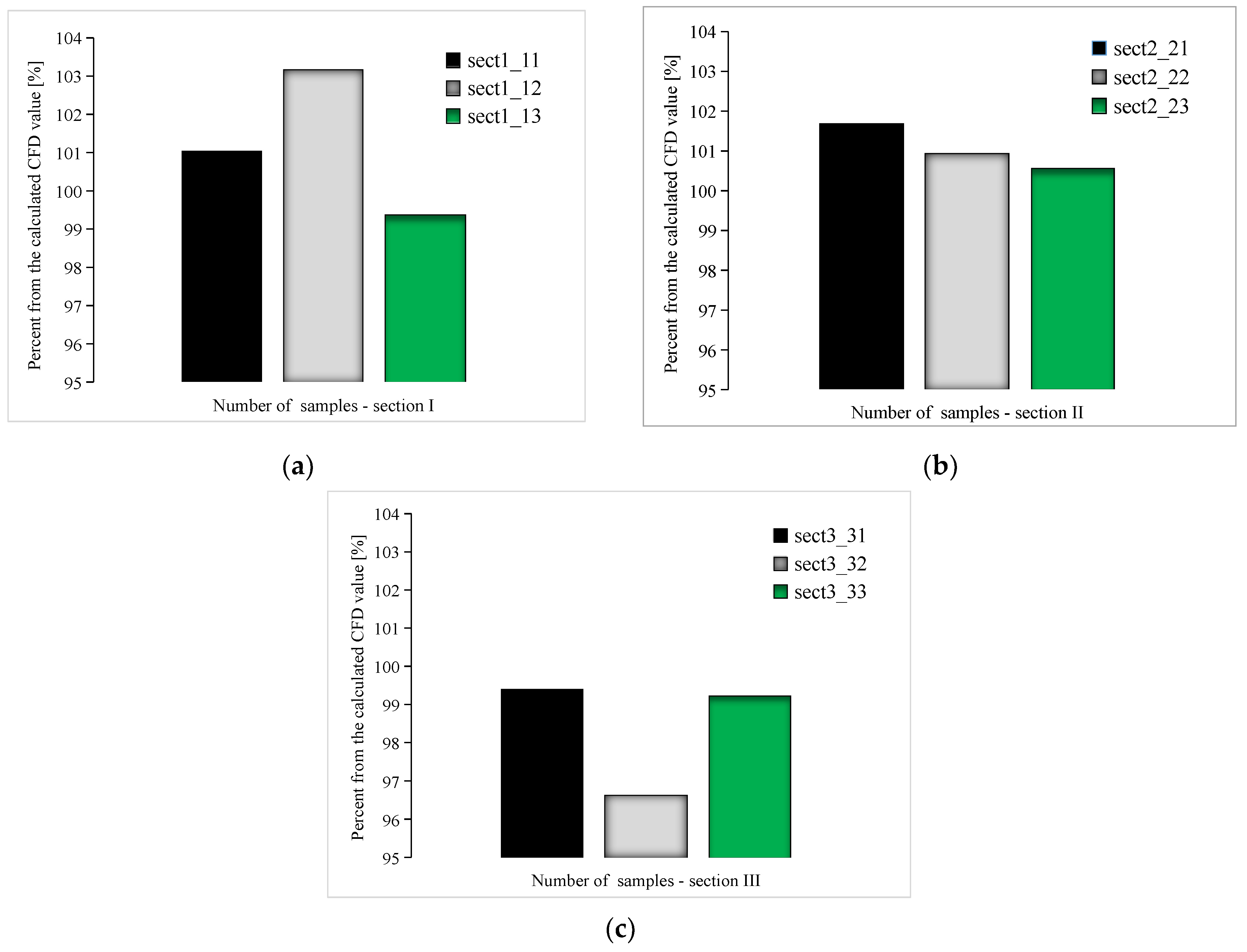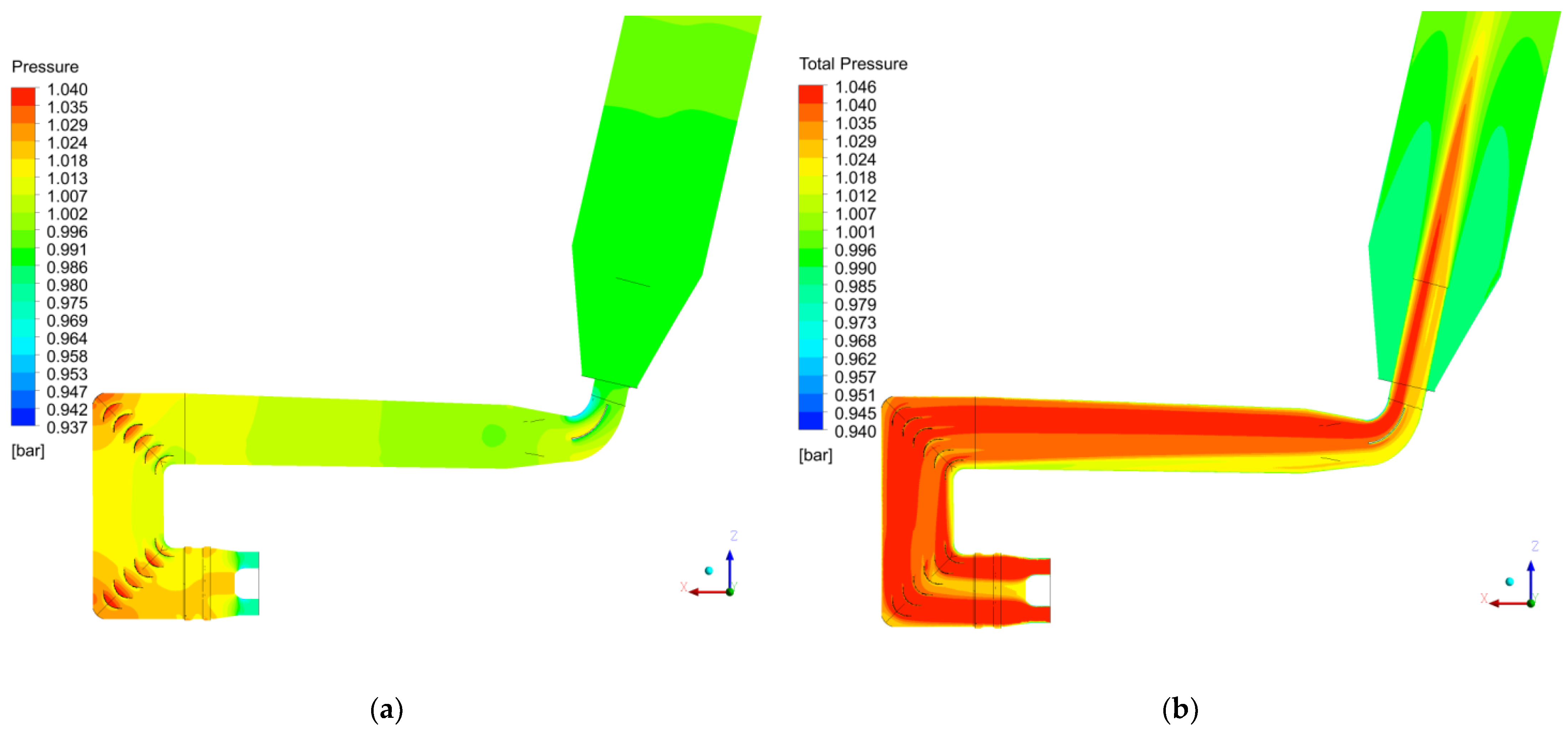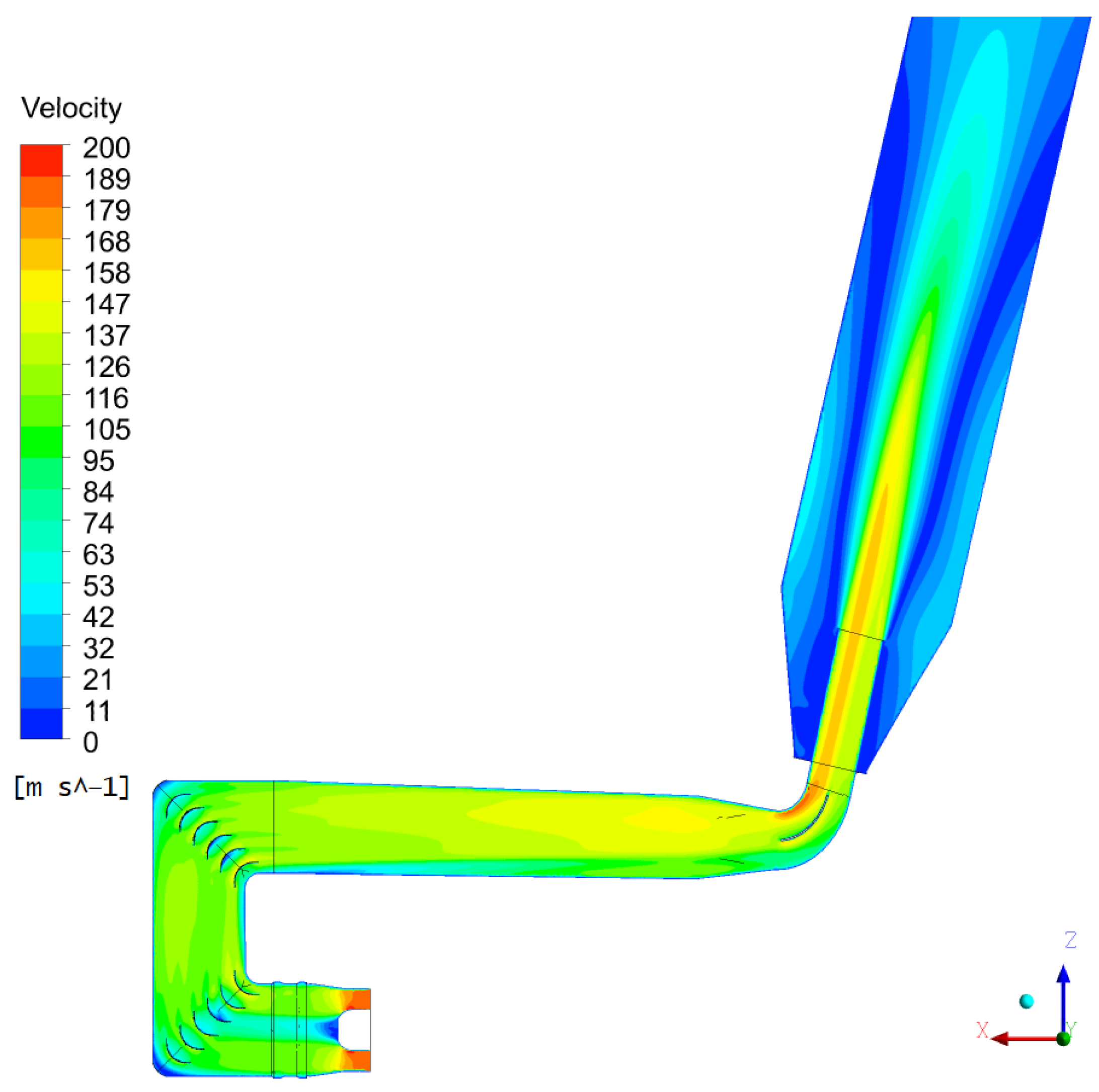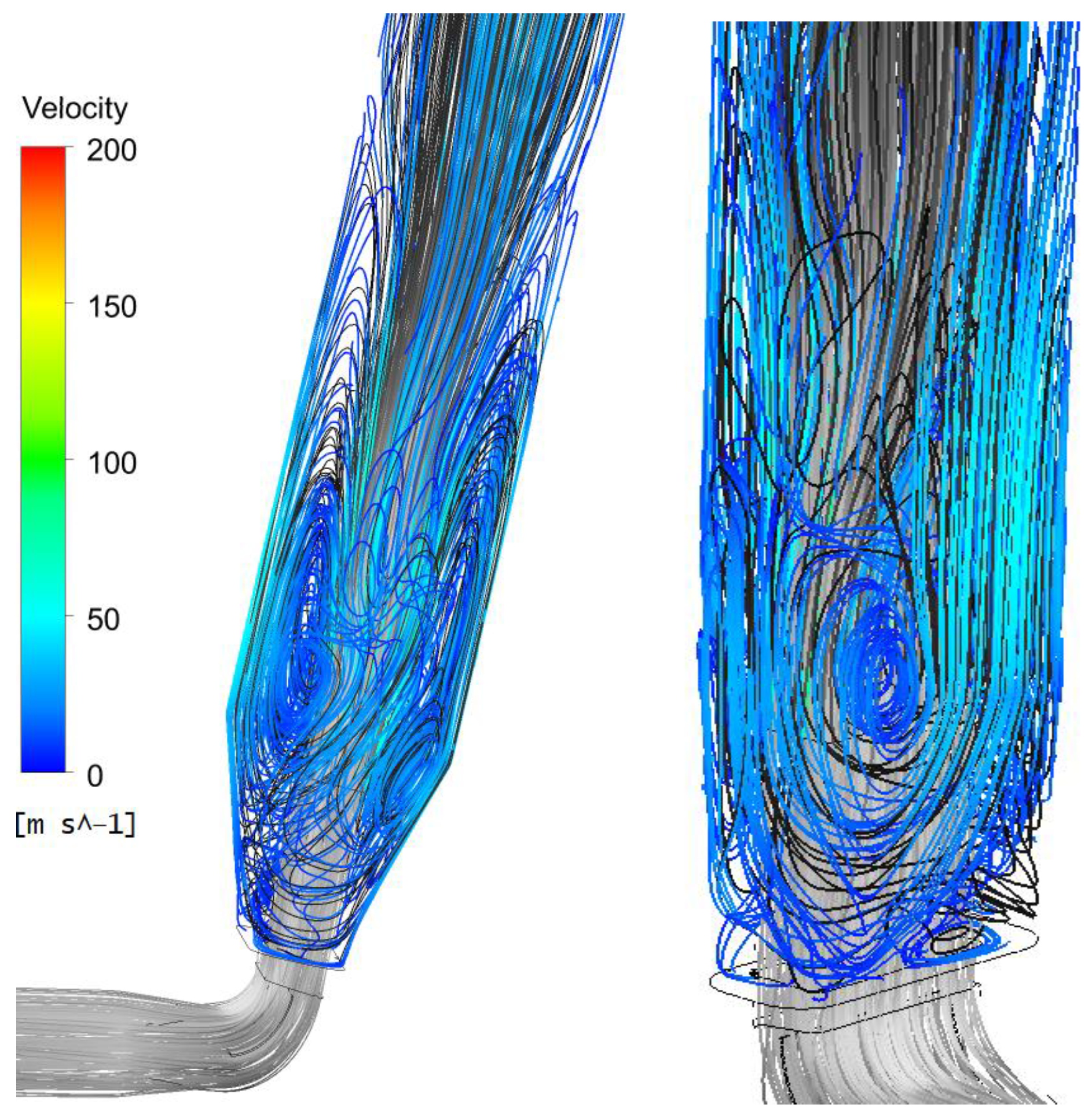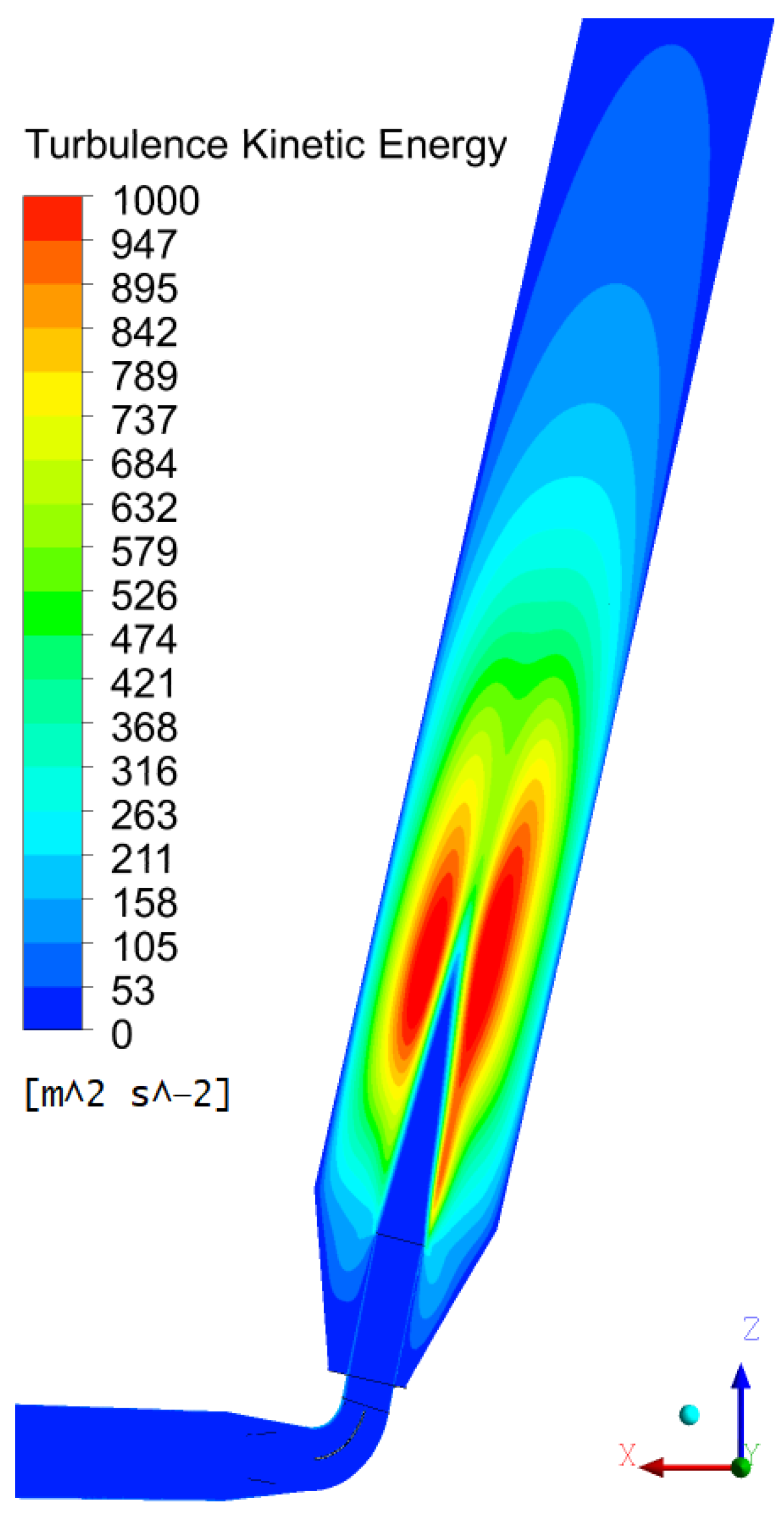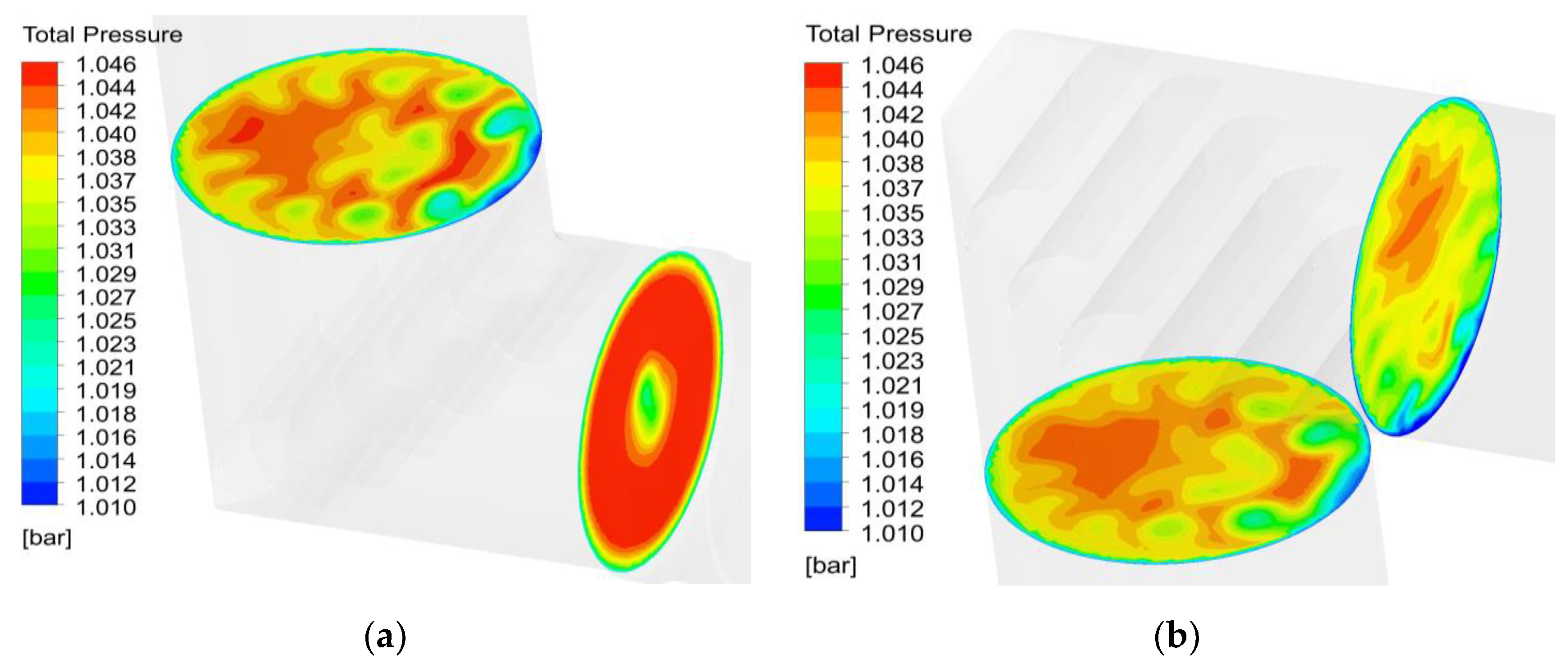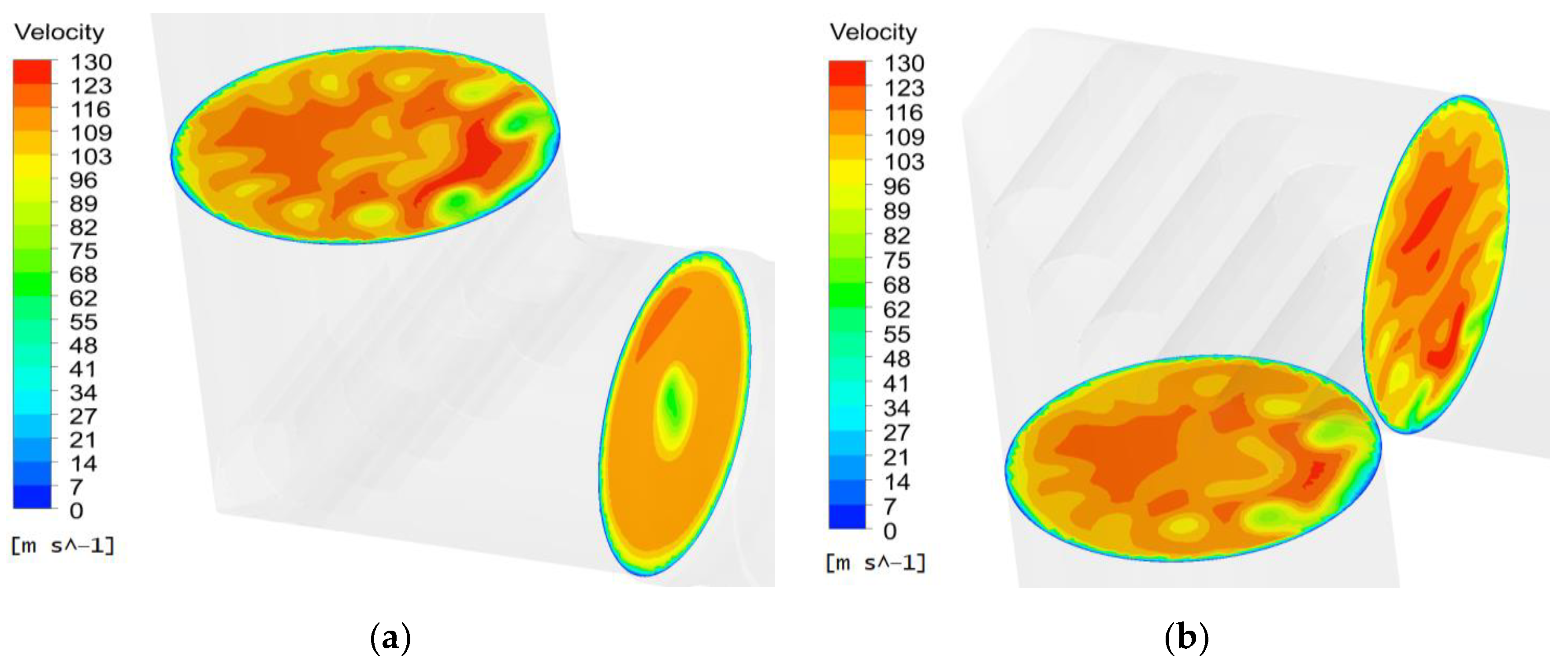1. Introduction
Upgrading propulsion systems is part of the natural evolution of any heavy piece of equipment that has a high service life. Maritime ships are no exception, particularly due to their high fuel consumption rate. New environmental and energy-economic challenges urge the marine propulsion market to adapt and grow in more sustainable ways [
1,
2]. Of course, there are many advantages of having more modern engines such as operation costs and overall performance; however, this sometimes comes at the cost of having to re-think the way the propulsion system integrates with the existing ship.
In marine propulsion, one common choice is gas turbine engines due to their higher performance, reduced maintenance, and optimized consumption [
3,
4,
5] when compared to their diesel counterparts. In addition, gas turbine engines are smaller, more power dense, and have lower noise and vibration levels. Additionally, their power to weight ratio allows for better maneuverability of the ship [
6], being an important advantage, especially for military vessels.
Aero-derivative engines [
7,
8,
9] have always been a good choice for marine applications and have been preferred in military ships since 1947 [
10]. Along with the robust safety and rigorous maintenance systems associated with engines derived from the aviation industry [
11], there is also the problem of the high initial cost, the requirement of more processed fuel, and the installation sensitivity when compared against the diesel counterpart. In terms of nitrogen oxides (NOx) [
12] and carbon dioxide emissions [
13], gas turbine engines are among the least polluting because of their finely tuned burning chambers and their continuous operating cycle, which maintains the temperature at a very constant level, under the threshold of NOx formation. On the other hand, catalytic converters are impossible to install due to the very high mass flow of air and the high exhaust temperature. Instead, emissions reduction, without significant investment costs, can be obtained by using fuels characterized by low carbon content and by using bio-fuels (also borrowed from the aviation industry).
The emissions are not only of ecological importance, as ship contamination from the exhaust gas is a problem that has been scrutinized in recent years both numerically and experimentally. Park et al. [
14] considered the deckhouse width and exhaust pipe gas as important design variables on the contamination process from the exhaust gas. While the deckhouse width had no significant influence on the exhaust gas, the exhaust pipe height was an important variable. With the increase in the pipe height, the sulfur dioxide (SO
2) concentration decreased. Good emissions can be achieved for a
yp/H (height of the exhaust pipe/height of the deckhouse) higher than 2. According to Bral et al. [
15], the performances of an exhaust system, from the emission point of view, can be evaluated through back-pressure and exhaust velocity. The main aim of the work in [
15] was to develop a computational model for exhaust systems and further study the pressure and velocity inside the vessel for different working conditions.
The revamping program sought to replace the existing Rolls-Royce Tyne RM1C with the newer P&W Canada ST40M. This will be carried out with minimal intervention on the existing ship, in order to preserve its other functions and its overall safety during operation. With such changes, however, certain parameters such as turbine outlet back-pressure may exceed the designer’s specifications, particularly if a more powerful engine is installed in the same space. Increased back-pressure inherently leads to greater fuel consumption and engine thermal loading. This is because the engines have to assure additional mechanical work in order to compensate for the under-expansion of the exhaust gases [
16]. According to [
17], a lower value of back-pressure assures a more efficient operation of the engine. Sapra et al. [
18] studied, using computational fluid dynamics (CFD) and experiments, the effect of back pressure on the marine diesel engine performance. Their research determined that the fuel consumption increase was small, in relation to the exhaust receiver, exhaust valve temperature, and air–excess ratio, which were the most affected parameters by the high back-pressure. The effect of the exhaust back-pressure is also described in [
19], where the performances of the engine were determined using neural network modeling, exploring in this way the relation between the inputs and outputs of the engine system. However, for aero-derivative engines that depend on the expansion ratio across the turbine, these effects may be much more detrimental.
The replacement engine choice took into account the requirements such as class similarity, power, operation, efficiency, overall weight, and dimensions [
20]. An engine with modular construction was chosen, which could conceivably be retrofitted with future upgrades that may be able to function with light fuels or alternate fuels (ethanol, methane etc.) and gaseous fuels (natural gas and propane-butane) [
21].
The revamping process of an ST40M engine for a T22 frigate was presented by Niculescu et al. [
22], where a new mechanical adaptation was developed. It shows the installation solution for the new engine, which has the gearbox located at the cold end of the engine, as opposed to the old engine, which had it at the turbine side.
This paper will focus on the development process of the exhaust structure and subsidiary systems, designed after replacing the Rolls-Royce Tyne engine with a Pratt–Whitney ST40M. Substituting an out-of-date propulsion system or updating it requires, most of the time, a new adaptation of the available space to suit the demands of the air intake, exhaust, and ventilation systems, corresponding to the engine performance.
The new engines have a different mechanical coupling system, which means that they will be installed backward when compared to the original ship engines. This makes the inlet and outlet manifolds much more complicated (length, number of bends, size packaging, safety margins as well as maintaining the capacity for an integrated ventilation system).
Hence, this paper aims to investigate the challenges brought by the maximization of the static pressure differences without compromising the main exhaust flow and also the process of using the natural draught from the exhaust flue to achieve ventilation in the engine enclosure.
2. Numerical Analysis
2.1. Geometry Definition
The performances and characteristics of aero-derivative engine ST40 were analyzed and compared with the Tyne RM1C engine, in order to ensure a proper fitting and to establish whether additional benefits such as increased propulsion efficiency and reduced weight are brought by this change [
22]. Following the dismounting of the Tyne engine and the ducting connected to it, the engine compartment was studied to determine the maximum dimensions in which the new ducting could fit.
The revamping program requires many changes in the ship configuration; however, the main phases necessary for the exhaust manifold are outlined in
Figure 1. The initial design starts with changes in the exhaust configuration available on the ship, so it matches the new engine orientation, but also has to integrate into the space available on the ship.
Establishing an optimal structure for the engine exhaust and properly adapting it to the ventilation system involved testing several configurations. All configurations had to meet the construction requirements imposed such as limited space on board the frigate and aerodynamic requirements as well as the safety distances from the crew walking corridors. Other key factors that were accounted for included the inlet manifold pressure distortion, total pressure losses at inlet/outlet, capacity to entrain more than 1 kg/s ventilation flow as well as all the packaging requirements (e.g., safety margins, insulation space, integration with the ship architecture). Due to the narrow space available, the entire exhaust system was divided into multiple modules, in order to guarantee a faster installation of the system as well as a fast replacement, if needed. The aerodynamic design was aided by CFD using a variety of k-epsilon models that compensate for the rotation and curvature of the streamlines. Although not as acclaimed as the shear stress transport (SST), this model combines some of the flow separation prediction capabilities while not requiring a boundary-layer type mesh, which would have been prohibitive at the early design stage.
One of the specifications of the ventilation system was that the temperature within the enclosure that houses the ST40M engine must not exceed 60°C (due to risk of ignition of possible combustible materials in the enclosure). Once an exhaust system for the ship configuration was obtained, its design was simplified for the test bench and validated through CFD and experimental data.
Figure 2 presents the geometries for which satisfactory results have been obtained, together with the modifications made to each exhaust manifold (the changes are highlighted in gray). The differences between the cases are given by the geometrical changes in the cascade elbow area, the connection with the exhaust pipe (which was made through a plenum chamber as well as through a guide vane) and various ejection systems to ensure engine enclosure cooling, as follows:
- (a)
Cascade elbow with trailing edge entrainment and plenum chamber—Engine enclosure ventilation for this configuration was assured by a trailing edge entrainment. Through the numerical analysis, the mass flow obtained was insufficient to ensure enclosure cooling, being less than 0.4 kg/s.
- (b)
Vaneless elbow with asymmetric injection and plenum chamber—Changes were made in the elbow area and the ejection system. This solution offers low mass flow for cooling and high-pressure losses. The vaneless elbow did not bring any improvements on the results.
- (c)
Cascade elbow with annular ejection, cylindrical, and guide vane—The major changes brought by configuration (c) were for the ejection system (annular ejection) and the connection with the exhaust pipe (guide vane). An increase in the mass flow for enclosure cooling was observed, but was not considered sufficient.
- (d)
Cascade elbow with annular ejection, high speed with guide vane—For this case the annular ejection and guide vane plenum were maintained, changing only the position of the ejection system and the pipe diameter before it. The mass flow for the engine enclosure cooling obtained was more than 1.2 kg/s.
Figure 2.
Configuration of the engine exhaust system. (a) Cascade elbow with trailing edge entrainment and plenum chamber; (b) vaneless elbow with asymmetric injection and plenum chamber; (c) cascade elbow with annular ejection, cylindrical, and guide vane; (d) cascade elbow with annular ejection, high speed with guide vane.
Figure 2.
Configuration of the engine exhaust system. (a) Cascade elbow with trailing edge entrainment and plenum chamber; (b) vaneless elbow with asymmetric injection and plenum chamber; (c) cascade elbow with annular ejection, cylindrical, and guide vane; (d) cascade elbow with annular ejection, high speed with guide vane.
Out of the configurations presented in
Figure 2, the most promising results were obtained in the case where a volute (
Figure 2c,d) was used to extract the hot air from the engine compartment. The main problem of this configuration was the complicated geometry of the volute, which requires a complex manufacturing process, and also the limited space available around this section. For the other configurations, the mass flow calculated was not sufficient to ensure proper cooling.
Figure 3a illustrates the exhaust manifold connection with the hot air exhaust pipe and the final section of the manifold installed inside the exhaust pipe (
Figure 3b). The hot air evacuation from the engine enclosure made use of Venturi ejection, a phenomenon that occurs due to the velocity of hot gases flow passing through the exhaust pipe; the pipe to which is also connected the manifold body. Additionally, the pipe is provided with a butterfly valve of rectangular section, having the role of interrupting the air circulation through the piping, in the case of chemical attacks on the ship and in case of fire inside the enclosure.
This configuration was determined and optimized based on CFD analysis and represents the ship exhaust manifold. Ensuring the real working conditions of such a system in a test bench is difficult to achieve, consequently, the performance of the ejection system was not validated on the test bench, but when the engine and related components were installed on the ship. The experimental and CFD results presented hereafter do not contain the engine cooling enclosure system.
The test bench configuration for the exhaust system was simplified in the area of the third cascade elbow to fit into the bench dimensions and to ensure the evacuation of exhaust gases into the atmosphere. In the following are presented the numerical and experimental results obtained for the test rig configuration.
2.2. CFD Model
A steady state CFD analysis was carried out using the Ansys CFX solver. The designed geometry was meshed with Ansys ICEM using unstructured meshes, with cartesian infill in order to insure model stability and accuracy. In highly curved areas as well as in the areas considered of interest, a local mesh refinement was applied to increase the accuracy of the solution. To minimize the numerical diffusion and to determine the best trade-off between the resolution and numerical stability, a grid independence study was performed following the methodology by Drăgan et al. [
23]. Problems regarding the mesh quality were resolved before the Reynolds Averaged Navier–Stokes (RANS) test, obtaining an approximately 30 million elements mesh.
For the flow physical model, the standard
k–ε turbulence model with streamline curvature corrections was applied and the air was considered to behave as compressible. The model is mostly used for turbulent flows conditions, being utilized in many industrial processes due to its robustness, lower computational costs, and reasonable accuracy [
24]. Additionally, it proved to be reliable for free-shear flows, especially for flows with small pressure gradients.
Following mesh generation, the boundary conditions were specified as follows: Domain Inlet (mass flow: 11.55 kg/s, total temperature: 873 K), Domain Outlet (static pressure: 101,325 Pa), and the rest of the walls were considered adiabatic and without slip, since in real application they are smooth finished sheet metal surrounded by heavy insulating materials.
The operating point used corresponds to an engine regime of approximately 94% of the maximum rotational speed. These conditions respect the experimental setup and are imposed depending on the exhaust system requirements.
The numerical campaign was realized using the second-order upwind difference scheme. Solution convergence was insured by monitoring the values of interest to reach a steady solution, domain imbalances of impulse, energy, and mass to be less than 1%, and residual monitoring to reach an acceptable value (10−4 or 10−5).
3. Experimental Methodology
The experimental investigations were carried out on the technological demonstrator equipped with an ST40M engine, as presented in
Figure 4. The functionality of the ST40M engine was tested for the entire operating domain by using the same fuel system, lubrication installations, control systems, and instrumentation designed for operation on the ship. A short description of the process can be found in [
25], where the results obtained for the intake manifold are presented.
The experimental tests were conducted on the entire range of regimes with respect to the ship operations, from start up, thermal stabilization to maximum power regimes. The engine regime was controlled by the automatic control system that transformed the demand from the operator (in form of a throttle position) in a variable fuel flow in order to achieve a stabilized regime through different control loops. The engine power turbine rotational speed was controlled by the automatic system of the dynamometer. For each rotational speed, a torque value was preset in order to simulate the propeller power demand across the operational range.
Dynamic and steady state tests were performed, simulating accelerations, decelerations, and different stabilized regimes. For steady state operations, the regimes were maintained constant for approximately 5 min in order to achieve thermal stabilization and to collect relevant experimental data.
In order to validate the CFD results and to determine the performance of the demonstrator, pressure and temperature probes were positioned in three different sections of the configuration. All experimental instrumentation and tests were realized in compliance with the Advisory Group for Aerospace Research and Development (AGARD) standards [
26].
Figure 5 presents the location of the three sections and the position of the measurement samples. The blue sphere represents the position of the total pressure sensors, while the red ones represent the total temperature sensors. Each parameter, pressure or temperature, was measured in three different locations spread equidistant across the duct circumference.
The probes were installed taking into account the flow path instrumentation blockage. The total area occupied by the probes is less than 2 percent [
27]. The probes used were as follows: temperature probes using type K thermocouple, total pressure probes, static pressure ports. The accuracy in the case of the pressure sensors was+−0.1% from the measured interval, whilst the accuracy for the temperature sensor was+−0.75% from the measured interval.
Figure 6 presents a part of the gas turbine experimentation complex where the technological demonstrator was installed. The picture from the left side illustrates the exhaust system coupled at the ST40M engine, while the other one shows the demonstrator assembly on the test bench.
Figure 5a also shows that the thermal isolation used on the exhaust pipes can be observed. The thermal isolation was used to minimize the heat transfer through exhaust pipes to the surrounding atmosphere. Such losses might affect the capacity of the exhaust gases to expand and entrain the ventilation flow from the engine compartment.
5. Conclusions
Substituting an out-of-date propulsion system or updating it requires, most of the time, a new adaptation of the available space to suit the demands of the air intake, exhaust, and ventilation systems, corresponding to the engine performance. However, Rolls Royce has announced the termination of production for the gas turbine Tyne RM1C and are no longer providing maintenance services, forcing the replacement of the old engine generation with newer ones.
Marine propulsion is responsible for a large part of carbon dioxide emissions. The energy efficiency of the propulsion system represents a sustainable approach for the environment, and revamping could be one of the solutions for older ships. Changes made by replacing the engines assure higher performance and improved fuel consumption, and therefore lower operational costs, lower emissions, and reduced maintenance costs. Proper engine operability and maintenance could lead to a more environmentally friendly propulsion system, and contribute to a reduction in the overall costs.
The paper presents the development and validation, by both numerical analysis and experimental testing, performed for an exhaust manifold of a T22 defense frigate, whose engine was upgraded to a Pratt–Whitney ST40M model. Numerical simulations of the exhaust manifold were carried out using commercial software Ansys CFX and were further validated against the experimental data. The experimental campaign was conducted in COMOTI’s gas turbine experimentation complex, where a part of the conditions and systems available on the ship were reproduced in order to ensure relevant operational environment.
Numerous configurations were designed and numerically conducive to a proper fitting of the geometry on the frigate, but at the same time, to ensure engine enclosure cooling. The results of the exhaust manifold for the ship configuration were presented only for the CFD analysis, which showed an improvement in pressure losses and in the overall stability of the flow.
For the test bench experimental campaign, the exhaust geometry was simplified and redesigned through numerical analysis. The results from testing campaigns, CFD and the experiments were compared in terms of the total pressure and total temperature in three different sections of the configuration. To determine the variation in these parameters on the pipe circumference, three monitoring probes were installed for each parameter. The comparison between the two validation methods showed good agreement, obtaining a difference of approximately 3.5% for the total temperature probes and 1.17% for pressure.
Certain findings from this research may extend to other applications that require natural draught from the exhaust gas; however, the main applicability of the study is to marine applications. The design process applied can be beneficial for exhaust manifold designers that encounter problems in the definition of the ejection cooling system. However, the test bench configuration and validation though the CFD analysis brings further studies closer to a technology readiness level crucial for the experimental tests carried out on board the ship.
